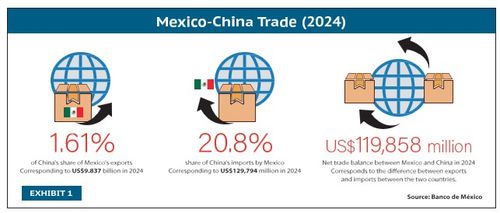
Mexico Between Two Giants: Balancing Foreign Investment Amid US-China Trade Tensions

Mexico stands at a pivotal moment in its trade and foreign investment policy. With mounting pressure from both the United States and China, the country must develop a strategy that strengthens its economic sovereignty, while remaining a competitive hub for foreign direct investment (FDI).
In 2024, Mexico’s trade deficit with China soared to $119.8 billion, underscoring a massive reliance on Chinese imports, particularly in the manufacturing and electronics sectors. At the same time, 83% of Mexico’s exports are destined for the U.S. market. These imbalances expose Mexico’s vulnerability to geopolitical fluctuations.
China-Mexico Trade Relations: Tariffs and Tensions
Under President Claudia Sheinbaum’s administration, Mexico has proposed new tariffs on imports from countries without trade agreements—China included. This policy aims to reduce Mexico’s dependence on Chinese imports and close the trade gap.
Yet Mexico-China trade relations are far from simple. Despite tariff threats, Chinese companies such as BYD and Jiangyin Hongmeng are still evaluating investment opportunities in Mexico. However, key investments like the $600 million BYD plant in Jalisco have stalled amid rising uncertainty.
“This geopolitical chess game has affected the willingness of Chinese companies to invest in Mexico.” — Laura Acacio, Jiangyin Hongmeng Rubber Plastic
Mexico’s Foreign Investment Strategy: U.S., China, or Both?
Experts like Enrique Dussel Peters from UNAM stress that aligning exclusively with the U.S. is not viable. Mexico must balance trade relations carefully:
20.8% of Mexico’s imports come from China
40.2% from the U.S.
Only 1.6% of Mexico’s exports go to China

Mexico’s trade strategy must acknowledge the importance of both partners. While the U.S. remains a dominant export market, Chinese imports are critical for manufacturing inputs, especially in sectors like automotive and electronics.
Plan Mexico: The Path to Sovereign Investment
The Plan Mexico initiative seeks to increase national competitiveness and rebuild investor confidence. However, recent FDI trends reveal serious concerns:
New investments dropped 39% in 2024, totaling only $3.17 billion
Profit reinvestment accounts for 77.9% of total FDI
Mexico dropped from 21st to 25th in the 2025 Kearney FDI Confidence Index
[📈 Refer to FDI charts: by type, flow, and sectoral breakdowns]
Despite these challenges, Mexico remains attractive for nearshoring due to its location, labor cost advantages, and the USMCA trade agreement. To capitalize on this, Mexico must:
Ensure regulatory clarity
Maintain legal certainty
Strengthen infrastructure
Expand into strategic sectors like semiconductors, clean energy, and automotive parts
Conclusion: A Tricky Balance with Global Stakes
Mexico’s future lies in balancing foreign investment strategies between two superpowers. By implementing Plan Mexico, maintaining its USMCA commitments, and cautiously recalibrating trade relations with China, the country can remain competitive.
Rather than choosing between the U.S. and China, Mexico must navigate the new global trade order with pragmatism and foresight. Only a clear, long-term vision can safeguard Mexico’s position as a key industrial and investment destination in a fragmented world.



